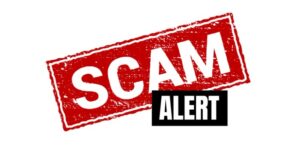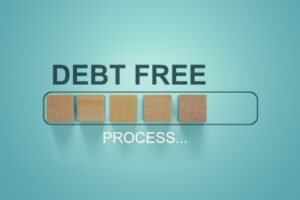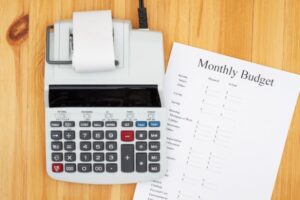Gain a fresh perspective on how to manage debt.
Challenges with debt are what has brought you here to New Leaf Debt Solutions. It can be easy to get overextended when you use credit, which leads to facing financial hardship with debt. To regain stability, you need to eliminate the debt and learn better tactics for managing debt moving forward.

This guide is designed to teach you how to manage debt effectively. It will also help you understand debt solutions you can use when debt becomes a problem for your budget. If you need help for immediate issues with debt that you’re facing, please visit our credit counselling page for more information or call (844) 248-2644.
What is debt?
Debt is the financial obligation you take on when you use consumer credit products. It’s money that you owe that you have to repay. And if you don’t manage your debt correctly, it can come with high costs and a high risk of causing financial hardship. On the other hand, with the proper strategy, you can keep costs low and use credit effectively without risking debt problems.
How to manage debt
The first thing to understand on your journey to managing debt effectively is to understand how different types of credit generate debts with different payment structures.
- Installment credit (loans) generally have fixed payment structures that change very little over the term of repayment.
- Revolving credit (credit cards) have payments that increase or decrease based on the current balance on the account.
Managing loans
Installment credit is generally easier to manage because the payments rarely change, if at all. You make fixed payments every month, which is easier to manage in your budget. Still, these tips can help you manage loans effectively:
- Always make sure you can comfortably afford loan payments before you apply.
- Setting up AutoPay can help ensure you never miss a loan payment.
- The payments on fixed-rate loans will not change, however, the payments on adjustable-rate loans can change when the interest rate changes. This generally makes a fixed-rate loan a better choice.
- Always shop for the most favourable terms and lowest APR possible.
- Extending the term on a loan will lower the monthly payments but increase the total cost with interest charges. Choosing a shorter term will increase the payments but reduce the cost of the loan.
- Refinancing a loan can help you lower the monthly payments but may generate added fees.
Managing credit cards
Revolving credit can be trickier to manage because the payments can change. Your bills will have a minimum payment requirement, which only requires you to pay back a small percentage of the credit line you’re currently using. Accrued monthly interest charges get deducted out of that payment.
If you add a large sum to a revolving credit line too quickly or your balance gradually increases from overuse, the payments can overwhelm your budget – either quickly or slowly! In either case, it’s often this type of debt that drives consumers into financial hardship. Managing credit card debt is critical to avoid having your finances fall into the red. These tips can help:
- Credit cards have significantly higher APR than other debts, so pay off balances as quickly as possible.
- Always try to pay more than the minimum payment requirement. These payment structures are not designed to pay off debt efficiently; they can double or even triple the cost of purchases!
- If you pay off your credit card balance every month, you can avoid interest charges entirely.
- Some credit cards offer grace periods, which give you extra time to pay off your balance before interest charges apply; take advantage of these if your cards have them.
- Never use more than 30 percent of an available credit line or you can hurt your credit score.
- Don’t spend money on a rewards credit card for the sake of earning rewards.
- Realize the rewards earned will generally be offset by interest charges within 2-3 billing cycles if you don’t pay off the balance in full.
How to reduce credit card debt effectively when you’re carrying balances
When you start to carry multiple balances on your credit cards, you may need to implement a debt reduction plan. This involves strategically paying off your balances in an efficient way. It will help you eliminate your debt quickly, so you can regain control and avoid financial hardship.
- Review your budget to find any expenses you can temporarily cut or cut back to maximize the cash flow you have available to pay off your balances.
- List all of your debts out, noting the current balance and APR.
- Decide which debt you want to pay off first:
- Paying off the highest APR debt first will help you save money and minimize interest charges.
- Paying off the lowest balance first will help you increase cash flow to tackle your biggest balances.
- Make the minimum payments on every account except the one that you identified and prioritized to repay first.
- Make the largest payment possible on this debt to pay it off as quickly as possible.
- Once it’s gone, you’ll free up the money you were using on that bill, giving you more cash to eliminate the next balance.
- Continue this process until you’re back to being debt-free.
What happens when you don’t manage credit card debt correctly?
- Immediately after missing the due date on a bill, the credit card company will apply finance charges to your account. These can add up quickly, depending on the card.
- After 30 days, your payment is officially considered missed and the creditor may begin reporting missed payments to the credit bureaus.
- After 60 days, the creditor will usually apply penalty APR. If they haven’t done so already, the creditor will begin reporting the missed payments to the credit bureaus.
- Missed payments are reported every 30 days after that until you are 120 days behind.
- After 180 days (6 months) without payment, the creditor will generally freeze your account, charge off the debt, and pass it to their collections department.
- After this, the creditor may attempt to collect payment themselves or sell the debt to a third-party debt collector. In either case, the account will have an R9 account status in your credit report, indicating a bad debt that’s passed to collections.
- The creditor or collector has the right to sue you to force you to repay the debt through the courts. This can lead to wage garnishment, where a portion of each paycheque you earn is taken to pay off this debt.
- Creditors and collectors must pursue legal action before the statute of limitations expires on the debt. This time varies by province but ranges from 2-6 years.
How much debt is too much?
As you’re managing debt and working to avoid financial hardship, there are some simple metrics that you can use to track when you may be taking on more debt than you can handle.
Debt-to-income ratio
Debt-to-income ratio (DTI) is what lenders use during the underwriting process when you apply for a loan. They use it to assess if you can take on a new loan and be able to afford the payments. It measures the amount of debt you have relative to your income.
To determine your DTI, divide your total monthly debt payments by your total monthly income. You want to keep your DTI below roughly 36 percent at any given time. This will allow you to apply for new loans without being concerned that you may be rejected because you have too much debt already. It will also help ensure that you can comfortably afford your debt payments within your budget.
If your DTI is above 50 percent, then you need to seek help without delay. This is too much debt for your income and it’s likely to cause financial hardship soon if it hasn’t already.
Credit card debt ratio
Another ratio you can use to maintain control of debt is your credit card debt ratio. This measures how much of your income you’re using just to cover the minimum payments on your credit cards. You should never need to spend more than 10 percent of your income to pay your monthly credit card bills. If you’re spending more than that just to meet your minimum payment requirements, it’s a sign you need to stop charging and focus on debt repayment.
Debt relief options
If you see that you’re starting to carry more debt than you can handle and traditional monthly payments aren’t working to pay off your balances, it’s time to explore options for debt relief. Debt relief options refer to any solution that makes it faster or easier to get out of debt. Each option comes with different benefits and drawbacks and it’s important to understand these, so you can choose the best solution to fit your needs and goals.
Debt consolidation
Debt consolidation refers to the process of taking multiple debts and rolling them into a single, consolidated monthly payment. The goal is always to reduce or eliminate interest charges. This allows you to focus on the principal (the actual debt you owe), instead of wasting money paying off accrued monthly interest charges.
The big benefit of debt consolidation is that when done correctly, it will not damage your credit score. You receive no negative notations on your credit report when you consolidate and as long as you pay off the consolidated balance on time, it will have a positive effect on your score.
There are two basic ways to consolidate:
Credit card balance transfer
This is where you transfer balances from high interest rate credit cards to a card with low or no APR. Many balance transfer cards offer 0% APR for 6-18 months after you first open the account. This gives you a period of time to pay off the balance interest-free. This usually works best for revolving debt amounts of $5,000 or less, as long as you have a good credit score.
Debt consolidation loans
This is an unsecured personal loan that you take out to pay off your credit card balances. You get a fixed-rate, unsecured personal loan at the lowest interest rate possible. Then you use the funds you receive to pay off your credit cards and other debts. This leaves only the loan to repay. This usually works best if you have good credit and owe less than $20,000.
Using home equity
Another option you may need to consider is using your home equity to pay off your credit card balances. You can also use a home equity loan or home equity line of credit (HELOC) to access the equity built up in your home. Then you use the funds to pay off your credit cards and other debts.
This option will also not damage your credit score as long as you keep up with the payments. However, cashing out equity can increase your risk of foreclosure if you can’t keep up with the loan or HELOC payments.
Debt management program
If you don’t have the means to solve your debt problems on your own, then it may be time for professional help. To enroll in a debt management program (DMP), you first call a consumer credit counselling agency, so they can review your credit, debts and budget. They help you understand all the options for relief we’re describing here. Then they help you identify the best solution to use in your situation.
If a debt management program is the right option for you, then you enroll through the credit counselling agency. A DMP is a professionally supported repayment plan that consolidates all your bills into one monthly payment. You find a monthly payment that works for your budget. Then the agency calls your creditors to work with them to agree to accept payments through the program and reduce or eliminate interest charges applied to your balances.
On average, consumers complete a DMP in about 36-60 payments. While you’re enrolled, your credit accounts are frozen and you can’t apply for new cards until you graduate. Enrolling in this program will create a negative R7 notation in your credit report. However, unlike other solutions, the notation will only stick around for 2 years after you leave the program. This solution works well for any debt amount over $10,000 and has no credit score requirement. You can enroll even with bad credit.
Debt settlement program
If you can’t feasibly repay everything you owe, then it may be time for a debt settlement program. This gets you out of debt for a percentage of what you owe. You enroll in a settlement program through a debt settlement company. You will open an additional bank account, so you can generate funds to make the settlement offers to your creditors.
Each month, you still make a monthly payment into this program, paying as much as you can afford to generate the funds you need quickly. Once you have enough money to make an offer, the settlement company contacts your creditors to negotiate settlements.
Once an agreement is reached, they pay the funds out of your settlement account and take their money out to cover their fees. Settlement programs generally take 12-48 months, depending on how much you owe and how quickly you can generate funds for offers.
This will also generate negative notations on your credit report for each debt you settle. It’s the same R7 penalty that you see with debt management, except it remains on your report for up to eight years. This is much more damaging to your credit, and have substantial fees, but it will usually get you out of debt faster and for less money. You can use settlement programs if you owe more than $10,000.
Consumer proposals
This is similar to debt settlement in that it allows you to get out of debt for a percentage of what you owe. However, instead of working with a professional debt settlement company to negotiate on your behalf, a licensed insolvency trustee reviews your finances to determine how much of your debt you can reasonably afford to repay. Then they set up a repayment plan that you must follow. Once you make all the payments, the remaining balances on your debts are discharged.
You can use consumer proposals if you owe more than $1,000 but less than $250,000 as an individual or $500,000 as a married couple. These proposals have some hefty fees and you can’t use it for secured debt. It does protect assets that you might lose in bankruptcy. However, it will damage your credit for up to eight years after the trustee files for a consumer proposal.
Bankruptcy
The final option for debt relief is to declare bankruptcy. It will erase all your debts, but that can come at a high cost. You can lose assets, such as your home and car, which can be liquidated to pay off your debt. The licensed insolvency trustee will take a full account of your assets and then facilitate their liquidation to pay back as much of your debt as possible. Then the remaining balances with be discharged.
Bankruptcy will weigh heavily on your credit. A first bankruptcy will be listed on your credit report up to six years from the date of discharge. A second bankruptcy can stick around for up to 14 years.






